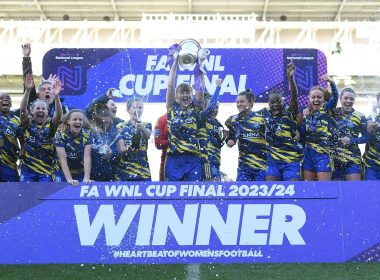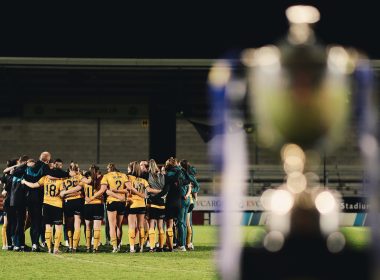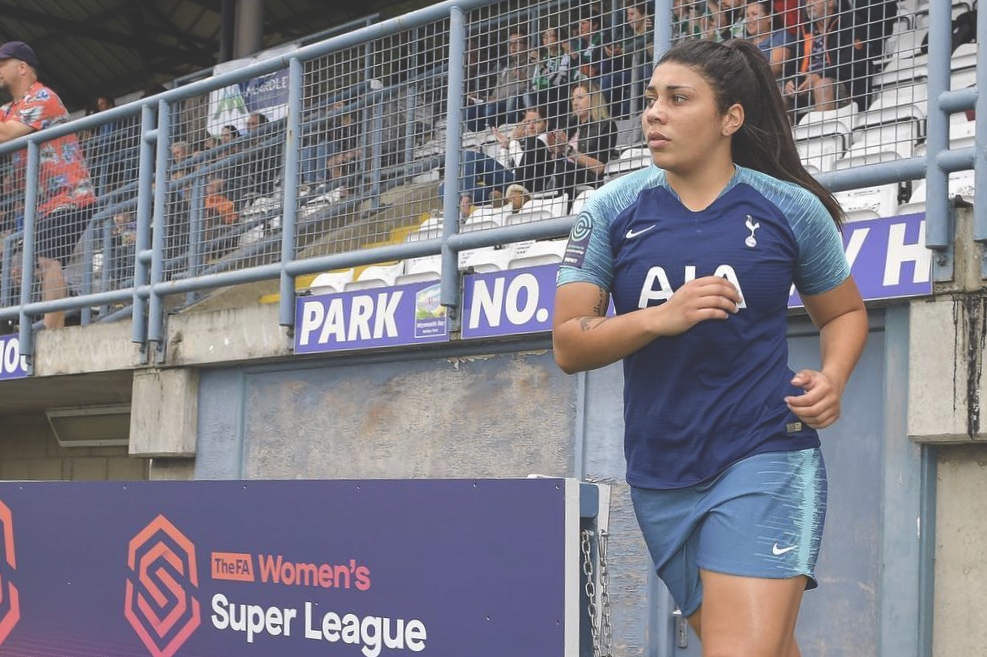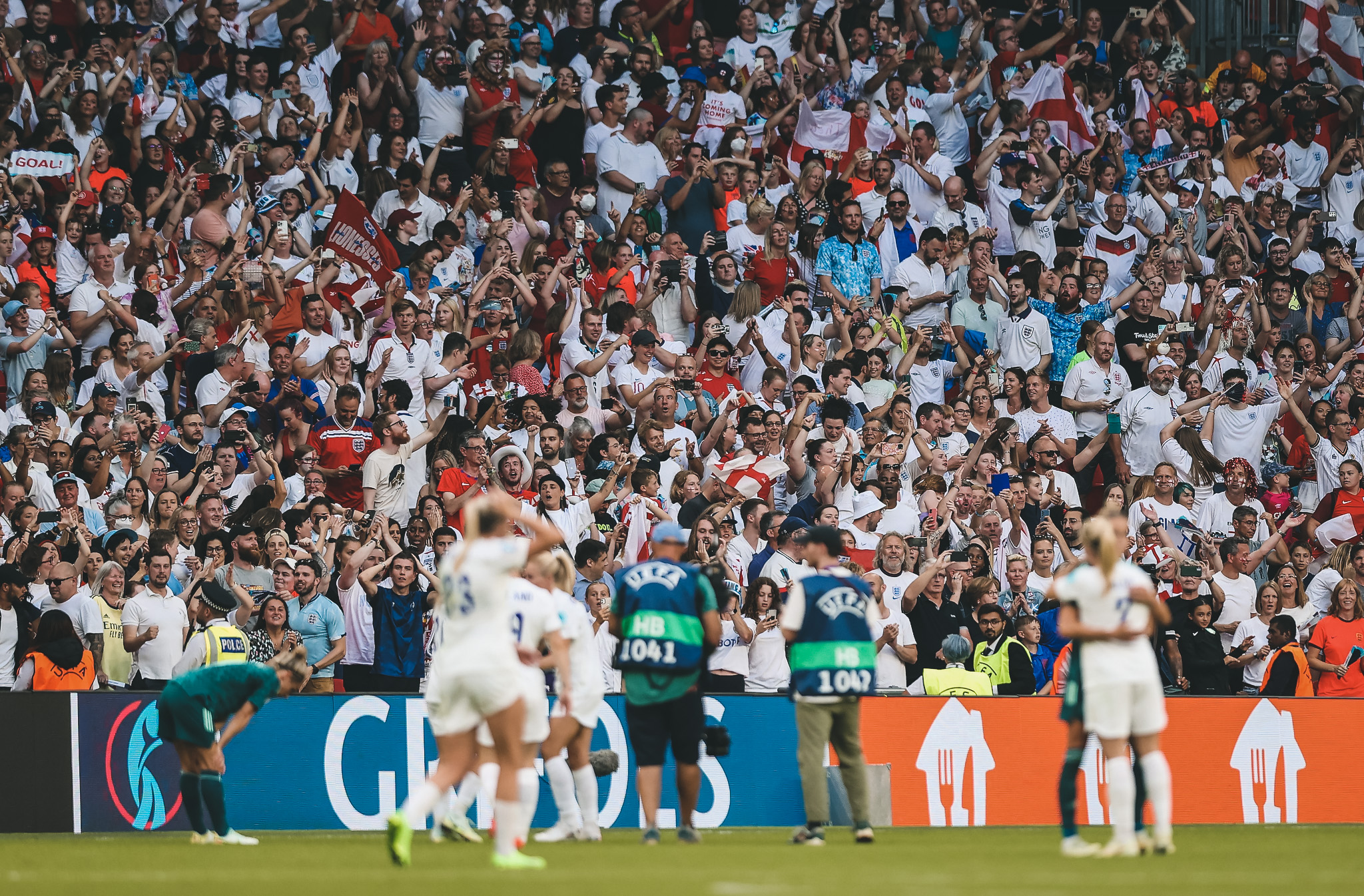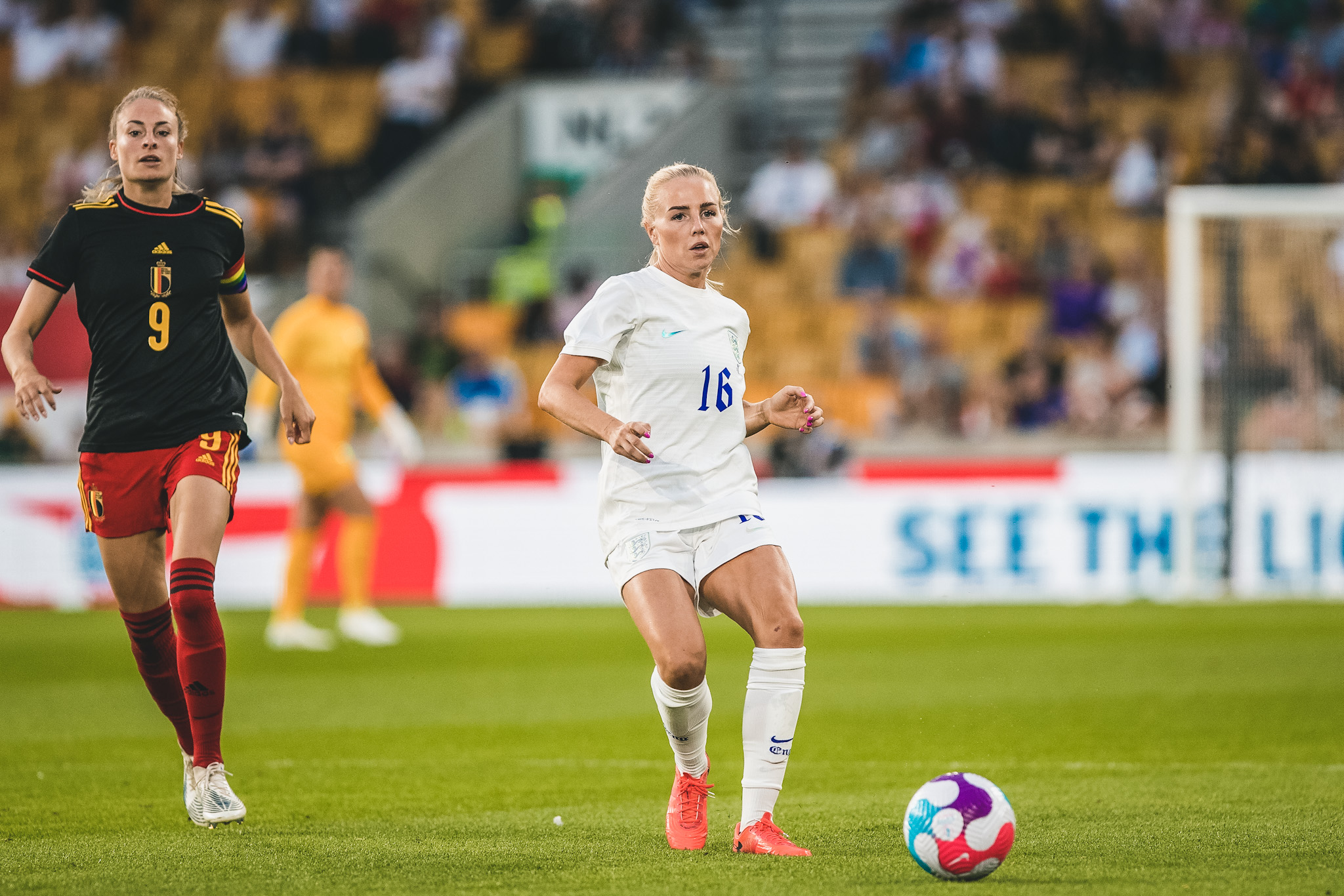As women’s football grows and spectator numbers rise, fan culture in the women’s game has become an increasing debate, with arguments both for and against fan segregation being introduced in women’s football grounds and some in the game expressing worry about the increasing partisan atmosphere at games. On the weekend of English football’s biggest game, Paul Wheeler explains why he feels women’s football has to embrace the tribal culture of football in order to grow.
This weekend Chelsea will take on Manchester City at Wembley in the traditional climax to another women’s football domestic season – the FA Cup Final. Over 50,000 tickets have been sold at Wembley for what is sure to be an occasion showcasing all of the best in women’s football – from the razor-sharp instincts of Sam Kerr to the pace and guile of Lauren Hemp to the sheer joy of seeing two of the best teams and some of the best players in the world go head-to-head on one of Europe’s biggest footballing stages.
But as well as being a unique stand-out occasion on the pitch the Women’s FA Cup final is fairly unique off it in English womens’ football as being one of the few matches where fans are actively segregated as they have been for many decades in the men’s game. And this segregation and the way it is implemented is currently a hot-button topic.
But with that has come, seemingly, some ruffled feathers. Some of the “older guard” in the women’s game have argued that with the increase in crowds women’s football is going down a path similar to mens’ football – they argue that the increase in crowds might lead to an increase in foul language, hostility and abuse which in their eyes “lessens” the women’s game. We’ve even seen people arguing that segregating home and away fans is somehow “wrong” because it will mean that the inclusivity and friendship many value in the women’s game might somehow be lost. Some of the noisier away followings have had anecdotal reports of being challenged or abused merely for singing about their teams, notable Manchester United fans away at Reading.
We’ve had “old-school” women’s football fans complain that Arsenal players were being booed while taking corners at the North London Derby, as if this is somehow some slippery slope down to women’s football ultras fighting in the streets over whether or not Ash Neville or Noelle Maritz is the better fullback.
It’s a level of hysteria that is massively unwarranted, and is being increasingly challenged. Women’s football journalists like Tom Garry have argued passionately that in order to grow women’s football needs the tribalism and rivalries which at the moment seem largely absent from the women’s game (can you imagine, for example, Arsenal fans arguing they should be standing up and chanting the name of a Chelsea player at a match between the two teams as many claimed was “the right thing to do” after Fran Kirby announced a recurrence of her injury problems?
I’m going to put this brutally… If women’s football continues trying to deny the fact fans form tribes and continues to try and present itself as a some sort of “all in it together family” as want to be the case, their shortsightedness will harm the game.
I’d go further and say that anyone suggesting women’s football should be some sort of utopia where fans mix in stadiums and all cheer for each other’s teams every week is a patronising dream from people who clearly have no confidence in their fellow supporters to act like adults. It is an insult to women’s football and in its own way are echoing the outdated views of football fans as thugs that led to the dark days of the 80’s in the men’s game and, in the most extreme case, to the vile lies of The Sun post-Hillsborough being believed by many.
Now, that’s not to say that men’s football doesn’t have major issues – we all know about the sexism and bigotry blighting grounds around the country, the vicious chanting that regularly crosses lines in the name of “banter” etc, etc. But in trying to not repeat the mistakes men’s football has made, there is a significant section of women’s football fans who, in claiming that women’s football is more open and tolerant, are actually being the opposite.
This summer the game will find itself at a crossroads…at the Women’s Euros we’re seeing both discussion of some of the largest crowds England women will see as a positive and the juxtaposition of the “worry” that if England are as successful as we all hope they’ll be, the “wrong” kind of football fan will arrive. One who supports their team above all others but at the same time will have a rivalry with other countries, will heckle the opposition and basically do anything they can to cheer on their team.

It seems strange that women’s football in particular, with its emphasis on opening up and people finding a place to express themselves, would still have a significant minority who, based on their own fears or ideas of “correct” behaviour, want to restrict the way people express their support. It is even stranger that in doing so, some argue that women’s football, unlike the men’s game, should be seen as some sort of friendly day out – a massive children’s party or festival of friendship which happens to have some elite sport going on in the background. It’s almost as if at times, folk want to deny the basic premise of football, which is that it’s a competition. And as someone coming from the men’s game and another sport which has also tried to market itself as a “family sport” and suffered for it in ice hockey, this worries me massively.
Women’s football, remember, is 50 years and more behind men’s in the development of a fan culture. For many people coming to games, men’s football is their only point of reference, and men’s football…indeed football as a whole, is by its very essence a tribal culture. It is red vs blue, us vs them, town vs town, and the players on the pitch are representing more than just a football team. And banding together in support of those players, screaming their names to the heavens in song, venerating your heroes and heroines while doing everything you can to make sure their opponents can’t gain the advantage, is what fan culture is. It is being part of a team. Being part of an army.
It plays to something very deep and primal in the human emotional psyche. Something incredibly powerful. Something that, when used correctly, is joyous, wonderful, and more addictive than any chemical high. People show they belong in fandom with chants, with flags, with noise. And yes, with heckling the opposition. To try and eradicate that completely, or at least as some propose not allow people to group and actively argue against allowing fans to band together and form a tribe due to some misguided belief that if you do so they’ll forget to act with basic human decency or even argue that it is “unfair” to do so is to stifle the creativity, passion and emotion that is one of the key selling points of sport. It is a surefire way of turning women’s football into sterile, anodyne environments where on the surface everyone might be welcome, but nobody is allowed to be who they are. It risks stadiums and indeed entire clubs losing their identity, or at least being forced to surpress it to the point the only “unique” experience about travelling to watch women’s football around the country will be that the architecture looks a bit different.
Let me explain a little more here and try to get my point across, as someone who’s travelled all over the country and indeed the world watching football in both the men’s and latterly the women’s game on the importance of fans being allowed to form their tribes and feed competition, and how football crowds are the worse if you try and force that out of them.
I love the experience of home games in Coventry. As someone born and bred in this city nothing gets my heart singing like the swell of the Sky Blue Song at my men’s team Coventry City, or belting out “In Our Coventry Homes” with thousands of others.
Coventry United women’s team are establising themselves in the city still, the fan culture is still at an early stage, and as a radio broadcaster the experience for me is slightly different but I still love walking up the road from Coventry city centre to the Butts Park Arena under “my” Ring Road with its massive WELCOME TO COVENTRY mural, and make a tradition of opening every pre-match broadcast I do with a Coventry-made song, whether it be “Crash” by the Primitives, or the city’s modern-day anthem sung by the Enemy of “We’ll Live And Die In These Towns”. That is for the fan and proud Coventrian in me and others watching, because it is a marker of our city. It’s a sense of place and I hope that as time goes by and our fanbase develops it will be a marker to away fans. This ic Coventry. This is Red and Green Territory. This is our ground, not yours.
But by the same token, travelling with Coventry or indeed just looking at other fanbases I relish pulling up at away grounds and the team coach erupting in a yell of “UP THE COV” as we enter the ground. Or the moment vs Arsenal when a hard tackle went in on a Coventry player from Arsenal’s Jen Beattie and my instinctive defensive raising of the hackles at the yell from the stands near me from an Arsenal fan of “WELCOME TO THE PREMIER LEAGUE”. It’s those moments where the fandom comes out, raw and unfiltered, and the feeling of belonging to your team is strongest. The moments when you are ready to defend your lot against your rivals however you can because it’s who you are, too.
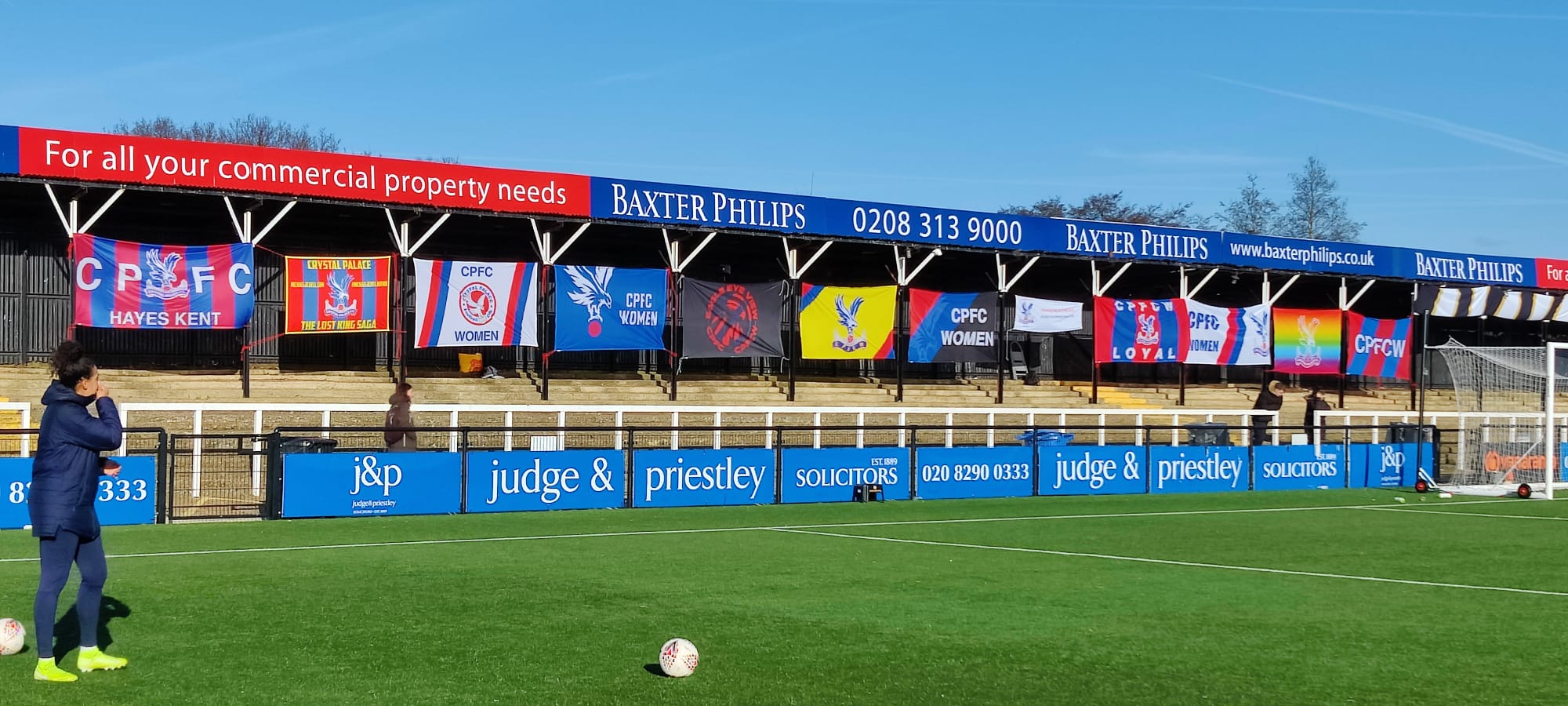
One of my visual memories of this season that will stick with me is Coventry playing Crystal Palace, and both home and away the Crystal Palace fans staking out their territory behind one of the goals with an array of red-and-blue flags – a massed display of South London pride, relocated to the Midlands. Or the volume and passion of the Sunderland travelling fans on the first game of the season. And perhaps most tellingly, the noise from a hundred or so Coventry fans echoing around a stunned and silent Vicarage Road after Mollie Green had fired home her thunderbolt from heaven in the last game of the season and how it seemed a hundred times louder than the noise 1100 or so Watford fans had been making all game.
That is what happens when people band together. People you’ve never met, or maybe only see once a week, become acquaintances between strangers who had nothing in common then happening to support the same team, then friendships are forged in long days sharing coaches up and down motorways, or cold rainy afternoons stood together in Kingsmeadow or Leigh Sports Village, Hayes Lane or Eppleton Colliery, all sharing the same hopes, and goals, and dreams, and moments of joy and despair together, supporting your team against a group of people who’ve formed similar bonds supporting theirs, all of you finding your own place to belong among the crowd, whether you’re in the end marked HOME every single week or in a rotating view of away ends.
Eventually, some of those friends often become your second family.
And I see this, and I wonder…why, in a sport that prides itself on inclusivity and welcoming all types of person, would you then deny people looking for their own place in the crowd the right to show their belonging out of fear? Why would you stifle the roar, or the pride, or the colourful displays of flags that brighten up often grey autumn and winter days?
Why would you put a limit on the joy?
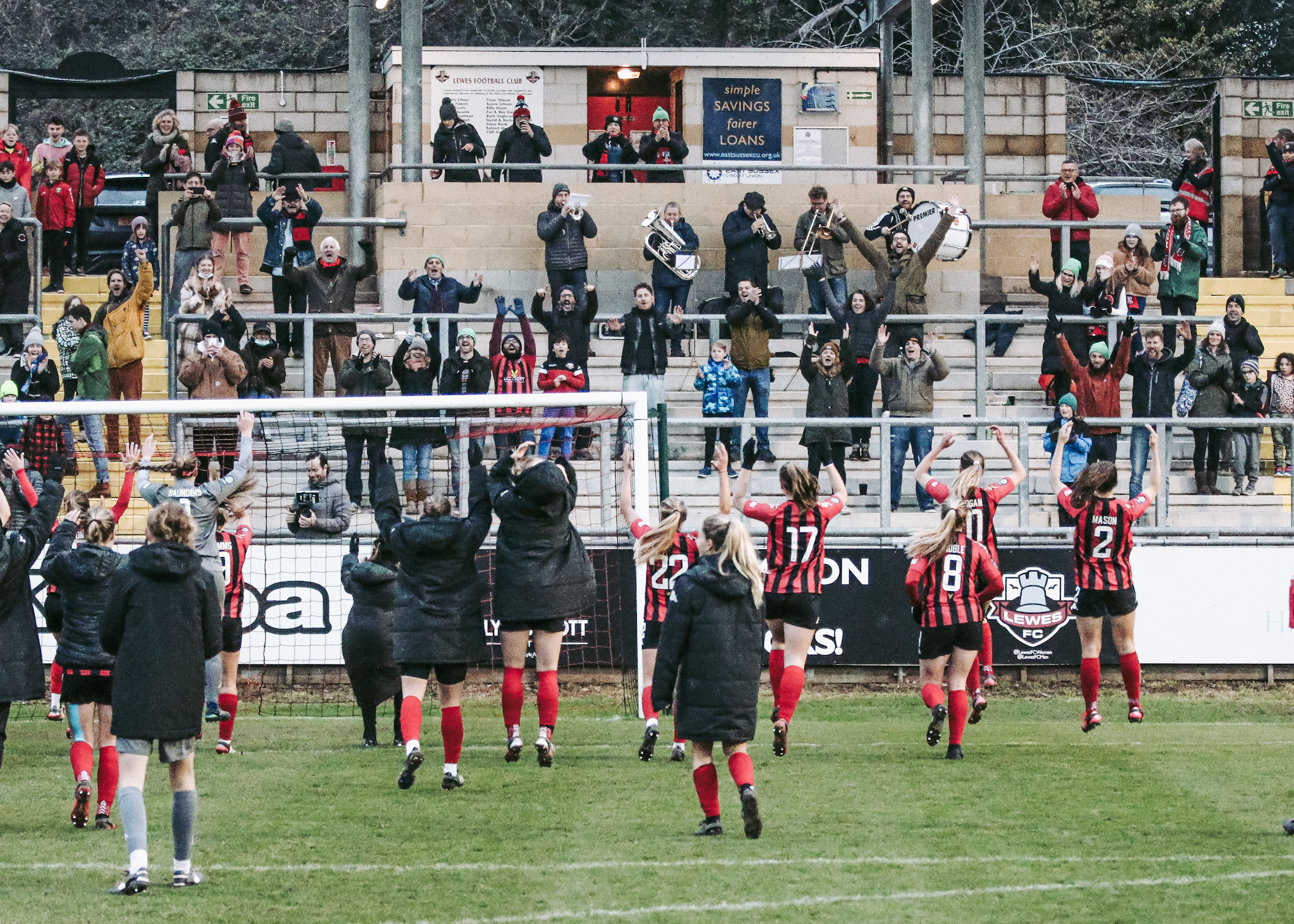
To argue that crowds should always remain mixed ignores the simple sporting truth that no fan walks into a football stadium or indeed any sporting arena with a primary objective of seeing friends from another team. Nobody from Man City or Chelsea will be walking into Wembley tomorrow looking forward above all else to the post-game party with friends, or sharing a drink with someone from the opposing end after the game. Yes, for many they are essential parts of the day, granted, and there is no reason that cannot be encouraged, possibly even by allowing a “mixed area” of seating if wished at stadiums.
For most fans, though, for the 90 minutes or more the two teams are in action, the folk at the other end or wearing a different colour jersey are the enemy. You want their team to lose. On a basic level, you want to be cheering and seeing them frustrated. Even if you know that the moment the final whistle goes you will be making your way to meet someone currently at the other end of the ground booing your player.
And in trying to keep crowds mixed women’s football is not only denying the basic nature of sport, but it is, at this point, insulting them. Nobody is arguing for the worst excesses of the men’s game to be brought into the women’s game, and women’s football will have to be aware of the need to self-police. But it is doing that already. We are far from the dark days of the 70s now, and more and more have the courage to stand up and challenge any crossing of the lines. Women’s football is leading the way in social acceptance and inclusivity and it can and will continue to do that because this is a sport and fanbase that has had to combat outdated attitudes just to exist, and there is no reason to suspect that it won’t continue to do so. The fanbase is mainly young, socially aware, and diverse now, and has grown up in an era of social change. By this point, they’re used to calling out the bad apples. Look, for example, at the universal condemnation issued to the WBA “fans” who this week abused Wolves’ Maz Gauntlett at the County Cup Final (before she silenced them with a goal) from both Wolves and, crucially, their fellow WBA fans, self-policing.
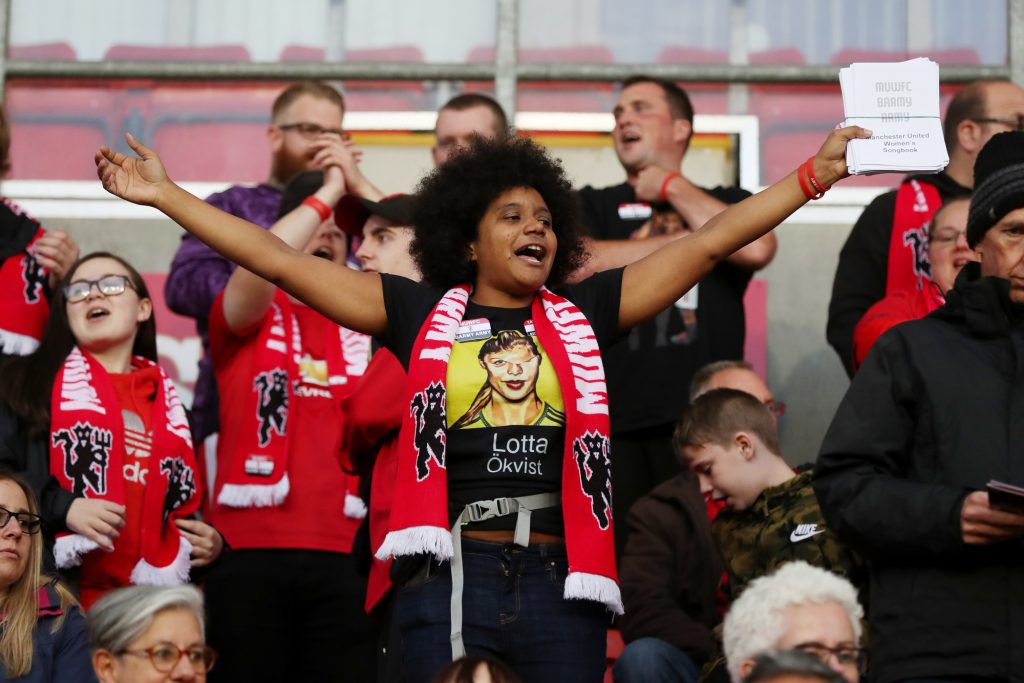
In saying “we don’t want crowds to split because we worry that if we do it’ll mean that grounds will become hostile places where fans feel unsafe” is to say that crowds cannot self-regulate. That they will become a mob. And that the players will be unable to take the torrents of abuse that will certainly result from this. And that attitude fundamentally fails to recognise what the women’s football fanbase is.
But this attitude is also insulting to the players, many of whom have spoken out publicly to say that they love atmospheres where tribalism and hostility is encouraged. It is to argue that somehow women’s football is “lesser” than the men’s game – less competitive, or the players would be less able to perform if they weren’t constantly told how good they are by all and sundry because “women’s football isn’t like that”. It is a fine example of the toxic positivity which argues that everyone should just be happy that women’s football exists and it shouldn’t be scrutinised on the same level as men’s, shouldn’t be taken as seriously as men’s. Shouldn’t receive the same level of fervent support as men’s.
It is backwards. It is patronising described as “supportive”. And games full of polite singing and applause don’t come across well on TV. One of the main criticisms detractors like to fire at the women’s game is “a lack of atmosphere” or “the empty stands behind the goals” that could be filled with partisan singing sections but aren’t right now.
There is a reason that the atmospheres that receive the most praise are often venomously partisan and yes, intimidating – if you don’t think so, just ask a Real Madrid Femeni player what the experience was like walking out at the Nou Camp. Ask players which the games they love to play in and they won’t tell you it’s the ones where the crowd are all mixed and getting on famously with nothing but positive encouragement – it’s the derbies.
Look at the way Emma Hayes has talked this week about how fans need to be split, and how important fan support can be. Look at the way players at Man United and even opposition managers have talked about the lift United’s famously vociferous travelling crowd gives them, with goalie Mary Earps going so far as to say “I love playing in front of them, but I’d hate to play against them. And I hope I never have to”
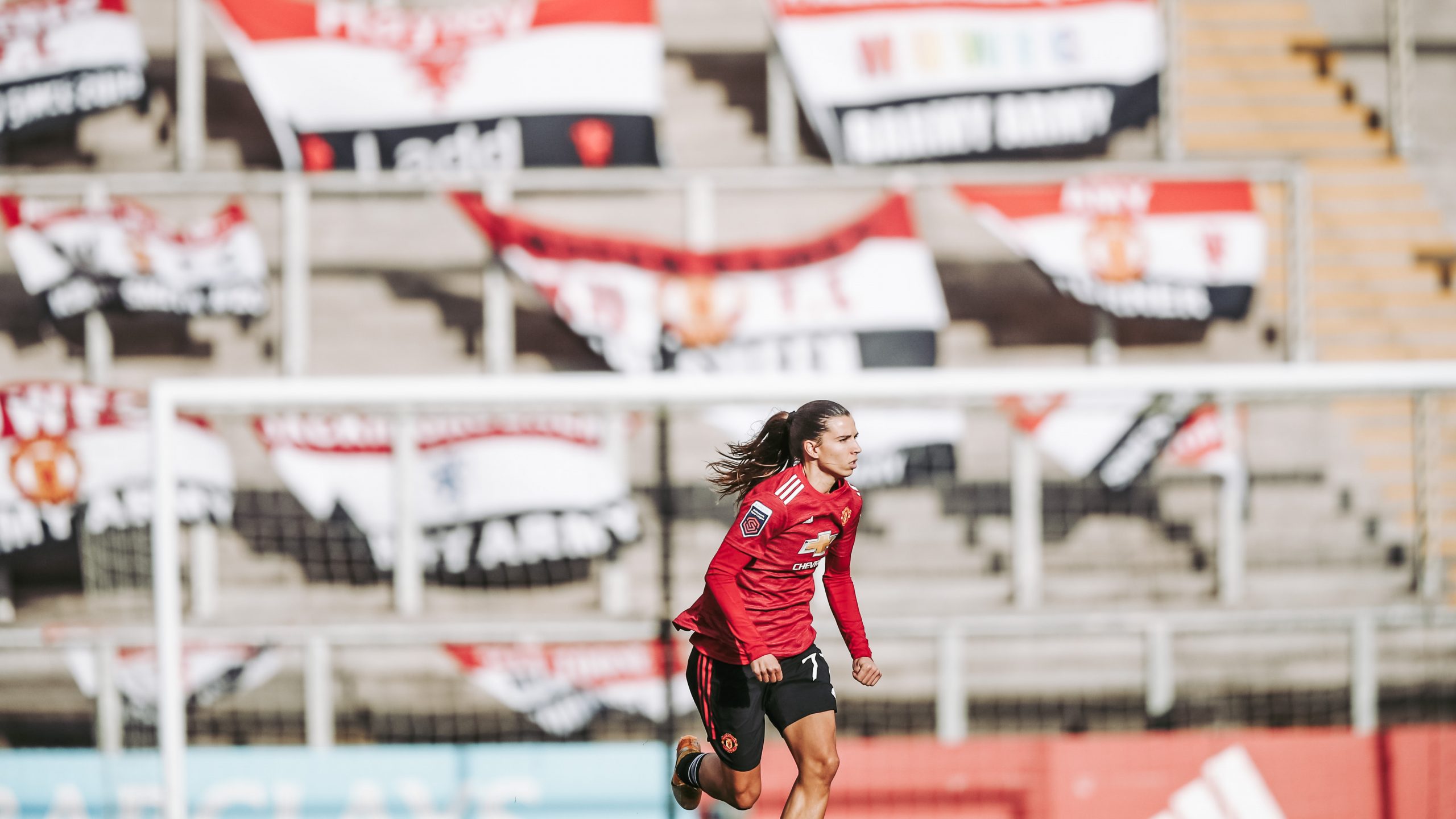
And frankly, as a fan and journalist, I want more of this next season. I want every ground to be a fortress away fans have to band together to conquer with their own wall of noise. I want each stadium to have its own sight, its own smell, its own feel. I want to travel to away grounds and see sights like the Flag Wall, one for every player, at Leigh Sports Village, held aloft by a baying crowd of Mancunians singing their repertoire of songs, and then feel the adrenaline rise as Man City fans answer them from the other end with a chorus of “Blue Moon” before a Manchester derby.
I want to see the Crystal Palace or Bristol City fans in the Championship form up in ranks behind the goal at the Butts Park Arena and wave their flags like battle standards, or stand at the other end as Liverpool fans belt out “You’ll Never Walk Alone” in challenge at Prenton Park in their own version of the Kop before answering them with an earsplitting chorus of “We’re green, we’re red, we came back from the dead, COVENTRY!”.
That is what fandom is. That is football pared down to its essentials…you and your mates at one end, them and theirs at the other, and both of you screaming your hearts out for your team. And that is what some in women’s football seemingly want to deny because of an overblown fear based on outdated attitudes and a paralysing terror of making the same mistakes men’s football made long, long ago, without realising that women’s football has a chance to build a culture that takes the good bits from the game and actively shuns the bad bits.
And until women’s football gives its fans true away ends, that can’t happen. And worse, those arguing against it it will always be standing in the way not just of their fellow fans looking for a place to belong, but also women’s football becoming the game and spectacle it is meant to be.



